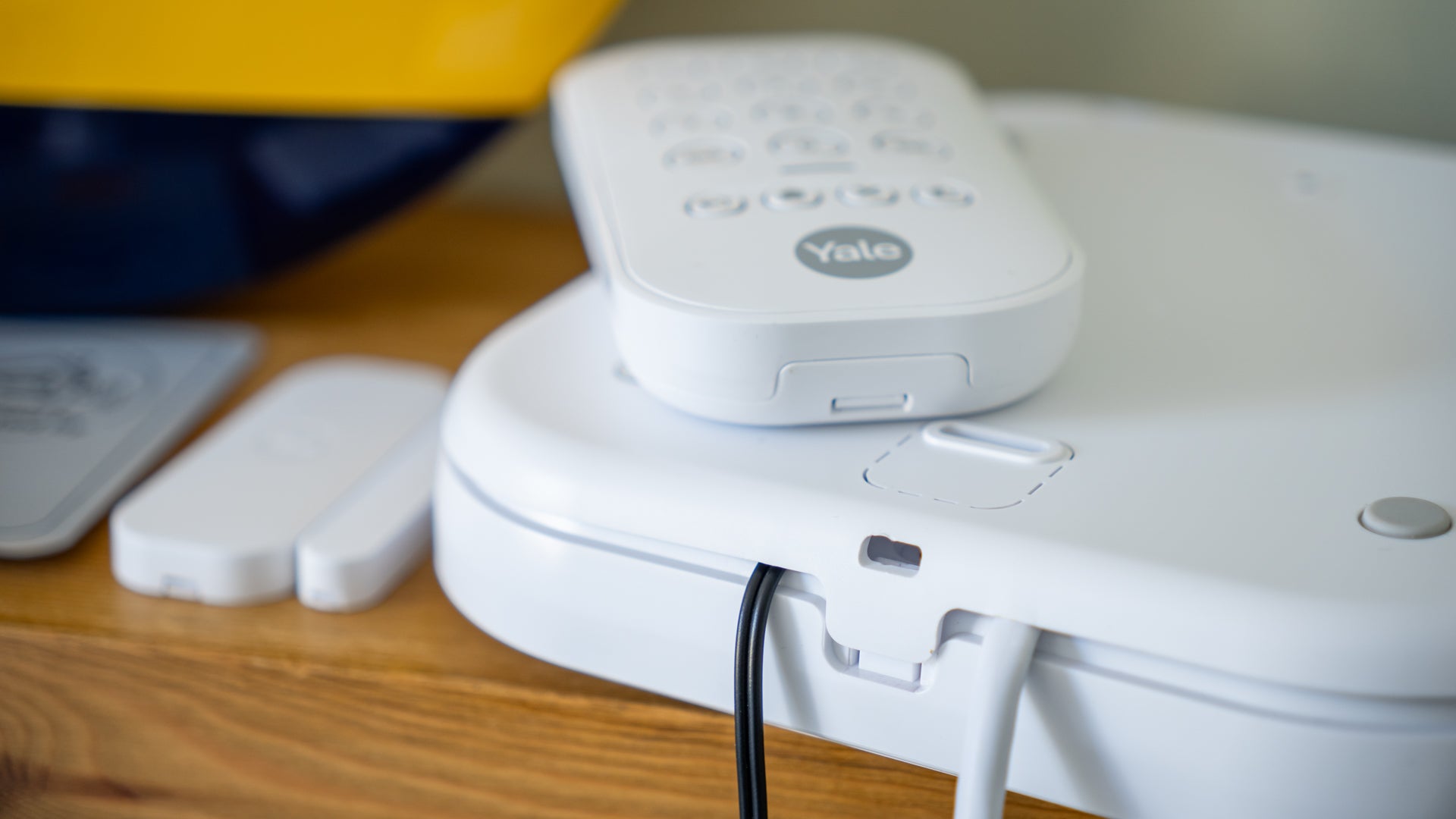
Yale is best known as a producer of door locks, but also sells a wide range of home security systems. It recently launched a new platform run by an app called Yale Home, which works with an equally new family of devices that includes security cameras, a video doorbell, and the alarm system reviewed here.
Called the Yale Smart Alarm, this is not to be confused with the older Yale Sync Alarm, which I reviewed recently and found to be lacking compared to some of the best home security systems from Eufy, Ring and Simplisafe.
The newer system tested here is Yale’s starter kit. A premium version with additional components is also available, and Yale sells each device individually, so you can buy the starter kit then build up a larger system over time.
This starter kit has everything you need to install a home alarm system, including a base station, a motion detector, two door/window sensors, a wireless keypad and an external siren. The system can be controlled either from the keypad, or with the free Yale Home smartphone app, which connects to the alarm via the internet-connected hub.
So how does Yale Smart Alarm starter kit perform, and how does it compare to the best home security systems? Read on to find out.
How I tested:
I installed the alarm system in my home and used it for a couple of weeks before writing this review. During that time, I tried every feature the system has to offer, adjusted settings to better suit my needs, and analysed how well the system worked.
Why you can trust us:
The Independent is committed to providing unbiased reviews and expert shopping advice across a range of home improvement products. Our team of experts has spent years testing and rating the latest smart home tech in our homes, gardens and under real-world conditions, so you can be sure our verdicts are authentic and based on personal experience with each product featured. When it comes to security systems, our expert testers consider everything from app features and ease of setup to ongoing subscription costs.
Yale Smart Alarm starter kit

This alarm system offers a much-needed improvement over Yale’s aging (but still available) Sync alarm kits. The inclusion of two door/window sensors is welcome, as often kits only come with one, and so too is the external siren, which acts as both a visual and audible burglar deterrent.
I also like the Yale Home app, which works well with Yale’s latest range of security cameras, door locks and its video doorbell. Also appealing is how all of these products work as part of a cohesive system that requires no ongoing fee. In a world where rivals like Ring charge for access to basic functions, Yale’s alarm system works with no monthly or annual charge.
Professional monitoring is available for a fee, but at £36 a month it’s more expensive than similar alternatives like Simplisafe, which costs £25 for a comparable level of service.
Other subscriptions include cellular backup (where the hub connects to the mobile phone network if your wifi goes down) for £5, or a £9 bundle that includes cellular backup, plus cloud storage for security camera recordings and automated phone call alerts.
Setting up and using this alarm is nice and simple. The kit includes everything you need to wall-mount each accessory, and the hub can connect to your router either with wifi or the included Ethernet cable. Arming and disarming is done either with the keypad or with a tap of the Yale Home app.
Yale Home is also compatible with a broad range of voice assistants and smart home platforms, including Amazon Alexa, Google Home, Apple HomeKit, Philips Hue and SmartThings.
Read the full Yale Smart Alarm review
Buy now £379.05, Amazon
Yale Smart Alarm starter kit hardware
This is a six-piece home alarm kit priced at £399.98. The kit includes two door/window contact sensors, a motion detector, a wireless keypad, an outdoor siren and a hub for connecting everything together. The kit also includes an Ethernet cable and a full set of screws, wall plugs and adhesive strips for wall-mounting each component.
Unlike similar systems from Ring and Eufy, this kit from Yale includes a wireless, weather-resistant and battery-powered outdoor siren, with a glowing Yale logo and a speaker with a maximum loudness of 100 decibels. The hub also contains a speaker and acts as a second siren; it can be set to chime when a door is opened.
Up to 100 accessories, like extra door/window sensors and motion detectors, can be connected to the one hub (compared to just 40 for the Yale Sync), and they’ll work at a range of up to 1km (0.62 miles). This is five times the range of the Yale Sync system and about 6.5 times the range of Simplisafe, and means you can add sensors to outbuildings like a shed or garage, for example, or to a gate at the end of your garden. This alone could be enough for some homeowners to consider the Yale Smart Alarm over other systems.

Devices connected to this alarm can be split into four areas. That way, if you’re working in the garage or garden office you can disarm that building while leaving the rest of your home armed. Similarly, you can arm the garage and shed while the house is disarmed, or only arm the downstairs of your home when you’re asleep upstairs.
The hardware is mostly what you would expect from a kit like this. However, I would prefer to see screws or more robust (and easier to use) clips for holding the rear panels of each component in place. The panels are released by pushing a release clip with a tool like a small screwdriver. No such tool is included in the box, and it isn’t possible to open them with your fingers; given you need to open each component to remove a cover from the pre-installed battery during the setup process, this is annoying.
I also spotted a couple of examples where the hardware design is ill-conceived. The rear panel of the hub cannot be fitted when the power and Ethernet cables are routed to exit from the bottom, when wall-mounted the right way up. It’s as if a pair of cut-out are missing, so it can’t be installed in the way Yale’s own video setup guide shows. I’ve demonstrated how the cables prevent the cover from closing in the photo below.

The keypad is also poorly designed, as the buttons are illuminated around their edges, instead of through the numbers and icons themselves. This means the buttons cannot be read in low light, since only their circular outline is lit up, not the numbers and arm/disarm symbols. It’s a design mishap that I’m amazed wasn’t spotted and corrected during the development of this system, and isn’t helped by how expensive it is compared to rivals like the circa-£150 Eufy Alarm kit or the equally-priced but much larger 11-piece Warwick kit from Simplisafe.
Those failings aside, the Yale kit was at least easy to install. Also, unlike Eufy Alarm, the Yale hub has a battery that keeps your alarm system online if there’s a power cut. You’ll lose smartphone app access, since a power cut would disable your router, but the hub’s battery means the alarm will continue to function and can be controlled with the keypad.

Yale Smart Alarm starter kit software
The Yale Home app is a big improvement over the seemingly forgotten-about Yale Alarm app used with the ageing Sync system. It’s the same app that controls Yale’s latest security cameras and Smart Video Doorbell, so if you already have those products the alarm can simply be added to your existing system.
Adding each of the alarm’s components to your system is just a case of scanning a QR code inside – although, as I referenced earlier, that means finding a small screwdriver or similar tool to prise the back off each accessory.
With everything connected, the app has a simple user interface that is easy to use. All you’ll really need are the big Disarmed, Away and Home buttons for tapping as required. Beyond that, the settings menu lets you adjust the siren volume, pick from a range of chimes made by the hub when a door or window opens, and create up to four security areas for your property – such as upstairs, downstairs, garage and whole home.

You’ll want to work through all of the settings carefully, as many useful functions are disabled by default. Keypad Force Arm is one such example, which when enabled lets you set the alarm while your door is open. To me at least, opening the front door then arming the alarm via the keypad feels more natural than leaving, closing the door, then reaching for my phone to set the alarm.
It’s also possible to set an alarm schedule, if that’s helpful for you, and to enable location-based alerts. These send a notification to your phone if you leave the area of your home without arming the alarm. Unlike Eufy Alarm, it isn’t possible to have the system automatically arm when you get to the end of the street. Guests can be added to the Yale app, so you can add your partner and give them access to the app and their own alarm code.
This system is compatible with several of the most common smart home platforms, including Amazon Alexa, Google Home and Apple HomeKit. With the Yale kit added to your system, you can use your voice assistant of choice to arm or disarm the alarm. More interesting is how the alarm also works with Philips Hue smart lighting. The setup process in the Yale app is quick and easy, and once connected to your Hue account your lighting will flash green when the alarm is armed, yellow when disarmed, and red when triggered.
Yale Smart Alarm subscription plans and monitoring explained

Yale’s subscription and monitoring options vary by country. Here in the UK there are three tiers to pick from. The first is called Alarm Plan and costs £5 a month, with your first month free. This enables the hub’s cellular backup system, where it will connect to the mobile phone network if it loses connection with your router, ensuring your alarm stays online.
The second option is called Secure Plan and costs £9 a month. This includes cellular backup, plus cloud storage for compatible Yale security cameras and video doorbells. It also enables a feature where you or your emergency contacts will be contacted by an automated phone call from Yale when your alarm is triggered. This is similar to what Ring Alarm offers in the UK as part of its £7.99 subscription.
Lastly, for £36 a month Yale offers a plan called Secure Pro. This unlocks professional alarm monitoring with emergency call out, along with cloud video recording and cellular backup. This represents a significant upgrade and positions Yale as a close rival to Simplisafe, where a human responds to your alarm, checks the situation and seeks to make contact with you and the emergency services. It’s a comprehensive take on home security, but the price difference between Yale at £36 and Simplisafe at £27.99 shouldn’t be overlooked. Picking between the two will come down to the ongoing cost, but also which hardware offering you prefer.
The verdict: Yale Smart Alarm
This is a good alarm system, but one partly let down by middling hardware. The door/window sensor and motion detector are both fine, and I like how an external siren is included in the box. But Yale has dropped the ball with both the hub and the keypad.
The former can’t be wall-mounted in the way Yale suggests, since the cables have nowhere to exit from the bottom on the unit, and the keypad buttons can’t be read at night because of how they are illuminated. I also have concerns with the fragility of the awkward plastic tabs used to release the battery covers of each component.
The Yale Smart Alarm Starter Kit is still a good product, if not a great one, and is much improved over the aging Yale Sync system. It is easy to set up and use, with a good smartphone app that is intuitive and reliable, while also working with other Yale products, like cameras, locks and doorbells. If you already own any of those products, this kit is the obvious way to build up a more comprehensive home alarm system.







